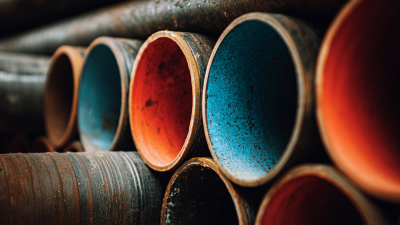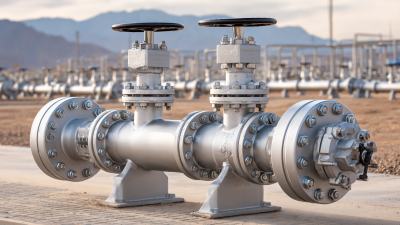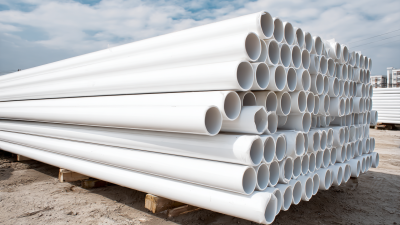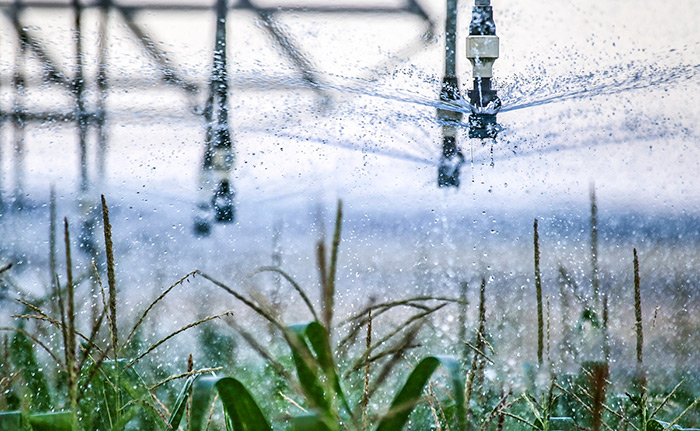How to Choose the Right U Pvc Pipe for Your Project
Table of Contents
- Key Factors to Consider When Selecting U PVC Pipes
- Understanding Different U PVC Pipe Grades and Their Uses
- Sizing Your U PVC Pipe: How to Measure for Your Project
- Essential Tools and Accessories for U PVC Pipe Installation
- Common Mistakes to Avoid When Choosing U PVC Pipes
- Environmental Considerations for U PVC Pipe Selection
- Enhancing Fluid Control: Analyzing the Market Trends and Performance of PVC Ball Valves in Industrial Applications
- FAQS
- Conclusion
- Related Posts
 When you're starting a plumbing or construction project, one of the most important choices you'll face is picking the right U PVC pipe for your needs. Honestly, with so many options out there, it can feel a bit overwhelming. That’s why understanding what your project really requires is so crucial. At Ningbo Pntek Technology Co., Ltd., we’ve got your back—we’ve been specializing in plastic pipes, fittings, and valves for over a decade. Our experience in the industry means we can help you find the perfect U PVC pipe that not only ticks all your technical boxes but will also last and perform well over time. In this blog, I’ll walk you through the key things to think about when choosing your U PVC pipes, so your project stays on track and goes smoothly from start to finish.
When you're starting a plumbing or construction project, one of the most important choices you'll face is picking the right U PVC pipe for your needs. Honestly, with so many options out there, it can feel a bit overwhelming. That’s why understanding what your project really requires is so crucial. At Ningbo Pntek Technology Co., Ltd., we’ve got your back—we’ve been specializing in plastic pipes, fittings, and valves for over a decade. Our experience in the industry means we can help you find the perfect U PVC pipe that not only ticks all your technical boxes but will also last and perform well over time. In this blog, I’ll walk you through the key things to think about when choosing your U PVC pipes, so your project stays on track and goes smoothly from start to finish.
Key Factors to Consider When Selecting U PVC Pipes
When you're trying to pick the right PVC pipes for your project, there are actually quite a few important things to keep in mind to make sure they perform well and last long. First off, it’s really helpful to get a grasp on the different types of PVC pipes out there. For example, you'll find options like schedule 40 and schedule 80 pipes — each one made for different jobs, depending on the pressure they need to handle and how thick they are. Interestingly, the global market for PVC pipes is expected to grow pretty significantly, with forecasts showing about a 6% annual growth rate over the next few years. Pretty cool, right?
Understanding Different U PVC Pipe Grades and Their Uses
When you're picking U PVC pipes for your project, it's pretty important to get a grip on the different grades out there. U PVC, which stands for Unplasticized Polyvinyl Chloride, is known for being tough and durable—so it's a popular choice for all kinds of uses. Usually, you'll come across grades like Schedule 40 and Schedule 80. Schedule 40 is the go-to for most home projects because of its standard wall thickness—great for plumbing and drainage stuff. On the other hand, Schedule 80 is thicker and stronger, making it better suited for commercial jobs where more pressure might be involved.
Another thing to keep in mind is what you'll actually use the pipe for. If you're dealing with chemicals, for example, you'll want to go with pipes that are specially rated for chemical resistance. Those are built to handle all sorts of corrosive substances, so everything stays safe and efficient. Some grades also come with UV protection, which is super handy if you plan on installing them outside and they’ll be in the sun all day long.
Basically, taking a bit of time to figure out what your project needs and matching that with the right U PVC grade will really pay off. It means your pipes will last longer and your project will turn out way better in the end.
Understanding Different U PVC Pipe Grades and Their Uses
Sizing Your U PVC Pipe: How to Measure for Your Project
When you’re picking the right uPVC pipe for your project, getting the size just right is super important. I mean, measuring correctly helps you find a pipe that fits perfectly with your existing setup — whether you’re dealing with home plumbing, farm irrigation, or big commercial jobs. So, start by measuring the diameter of the pipes you already have or the space where you plan to install the new piping. Usually, standard sizes will do the trick, but sometimes you might need to go for custom measurements if your project has specific needs.
Next up, think about how long your pipes need to be. Measure the distance between connection points, and don’t forget to account for any bends or fittings, which can add to the length. Oh, and the wall thickness of the pipe matters too — it can influence how tough the pipe is and how well it handles pressure. By paying close attention to these details, you make sure your pipe choice isn’t just fitting but also sturdy and reliable. Plus, staying updated on the latest trends and what's happening in the PVC market can help you pick a product that’s trusted and worth your investment for the long haul.

Essential Tools and Accessories for U PVC Pipe Installation
 When you're installing U PVC pipes, having the right tools and accessories really makes all the difference in making the whole process smooth and hassle-free. First off, you’ll want a good, reliable cutting tool—precision is key to getting clean cuts that fit perfectly. Pipe cutters or saws made specifically for PVC can help you achieve those nice, clean edges, which in turn reduces the chances of leaks down the line. Oh, and don't forget a deburring tool! It’s super helpful for smoothing out those rough edges, so your joints stay sealed tight without any weak spots.
When you're installing U PVC pipes, having the right tools and accessories really makes all the difference in making the whole process smooth and hassle-free. First off, you’ll want a good, reliable cutting tool—precision is key to getting clean cuts that fit perfectly. Pipe cutters or saws made specifically for PVC can help you achieve those nice, clean edges, which in turn reduces the chances of leaks down the line. Oh, and don't forget a deburring tool! It’s super helpful for smoothing out those rough edges, so your joints stay sealed tight without any weak spots.
As for joining the pipes, the right materials make all the difference too. Usually, folks use some kind of solvent cement to create a solid connection. Just make sure you pick a high-quality adhesive that’s compatible with your specific type of U PVC—it really boosts the durability and overall performance. It’s also handy to have a variety of fittings nearby, like elbows, tees, and couplings, so you’re ready to tackle whatever configuration your project needs. With the right tools and stuff on hand, installing U PVC pipes can actually be pretty straightforward—and way less stressful than it sounds.
Common Mistakes to Avoid When Choosing U PVC Pipes
When you're picking out U PVC pipes for your project, it’s easy to make some common mistakes that can end up costing you time and money. One of the biggest slip-ups? Not paying attention to the pipe’s pressure rating. If you use a pipe that’s not rated for the pressure your system will be under, you could run into serious problems like leaks or even complete failure. So, it’s a good idea to check the manufacturer’s guidelines and make sure the pipes can handle the environment and the kind of pressure you’re working with.
Another thing that trips people up is choice of size. Too often, folks go with pipes based on what’s available or just go for the cheapest option, without considering what the flow actually needs. An undersized pipe can cause annoying bottlenecks, while going way too big can mean higher costs and more maintenance down the line. Take the time to figure out the right diameter based on your flow rate — it really pays off in the long run. Getting the size right not only keeps things running smoothly but also helps your system last longer and saves you some headaches later on.
Environmental Considerations for U PVC Pipe Selection
When you're picking out U PVC pipes for your project, it really pays to think about the environmental side of things. U PVC, or unplasticized polyvinyl chloride, is a favorite because it’s durable and doesn’t require a lot of maintenance. Plus, industry reports say that PVC pipes can save up to half the energy compared to older materials, which is pretty awesome considering our global efforts to cut down carbon emissions.
So, choosing U PVC isn’t just about getting the job done; it’s also a way to contribute to sustainability efforts.
Here's a little tip—when you're selecting U PVC pipes, check out what recycling options are available in your area. Good quality U PVC can often be recycled and reused, which helps cut down waste and lessen the environmental footprint.
Another thing to keep in mind is how these pipes are made. The American Chemistry Council points out that modern manufacturing methods for U PVC have significantly lowered the emissions of harmful substances, showing a real commitment to eco-friendly practices.
By picking pipes made from responsibly sourced materials, you’re not only making a solid choice for your project’s performance but also standing behind sustainable manufacturing.
And one more tip—don't forget to look for certifications or eco-friendly ratings when you're shopping for U PVC pipes. These can really be a game-changer for making sure your project stays as green as possible.
Enhancing Fluid Control: Analyzing the Market Trends and Performance of PVC Ball Valves in Industrial Applications
In recent years, the demand for PVC ball valves has surged, particularly in industrial applications that require precise fluid control. The increasing focus on safety, sustainability, and cost-efficiency has prompted industries to adopt PVC ball valves, which are known for their superior durability and low maintenance. A comprehensive market analysis reveals that the global PVC valve market is projected to grow at a CAGR of 5.8% through 2028, largely driven by advancements in material technology and enhanced valve performance.
The construction of PVC ball valves involves a strategic selection of materials to ensure optimal performance under varying operational conditions. For instance, the body is typically made of unplasticized polyvinyl chloride (UPVC), which offers excellent resistance to corrosion and chemicals. The design includes a variety of components such as POM for the stem, EPDM or FPM(NBR) for the stem O-ring, and ABS plating for the ball, ensuring each part contributes to a robust and reliable valve system. Notably, the seat seal incorporates TPE, TPVC, and TPO, providing additional protection against leakage and wear.
Industry reports indicate that the increasing adoption of PVC ball valves across sectors such as water treatment, chemical processing, and food and beverage manufacturing is redefining market dynamics. Their lightweight design and versatility make them a preferred choice for engineers looking to enhance fluid control. As industries continue to innovate, the PVC ball valve market is expected to adapt and evolve, setting new standards for performance and efficiency in fluid handling systems.
FAQS
: The main types of U PVC pipes available include Schedule 40 and Schedule 80 pipes, each designed for specific applications based on their pressure ratings and thickness.
Schedule 40 U PVC pipe is widely used in residential projects due to its standard wall thickness, making it suitable for plumbing and drainage systems.
The intended use influences the type, diameter, and material compatibility of the pipes, which is crucial for ensuring optimal performance and longevity in your plumbing systems.
DWV PVC pipes are specifically designed for drainage, waste, and vent applications, making them suitable for efficient waste management solutions.
If a project involves chemical transport, it is essential to select U PVC pipes that are specifically rated for chemical resistance to ensure safety and efficiency.
The demand for PVC drainage pipes is surging in the telecom and construction sectors due to the growing need for efficient waste management solutions.
Certain grades of U PVC pipes include UV protection, making them suitable for outdoor installations where they may be exposed to sunlight and harmful UV rays.
The global PVC pipes market is expected to witness substantial growth, with an estimated compound annual growth rate (CAGR) of around 6% over the next five years.
Schedule 40 pipes are suitable for standard applications with lower pressure demands, while Schedule 80 pipes offer increased strength for use in commercial applications requiring greater pressure resistance.
Assessing the specific properties of different grades helps in making informed choices that enhance the durability and success of construction endeavors.
Conclusion
Thinking about starting a project that needs U PVC pipes? Well, it’s really important to be informed so everything turns out durable and runs smoothly. First off, you’ll want to get a handle on the different grades of U PVC pipes because each type has its own perks suited for specific uses. And don’t forget about sizing—making sure you measure your needs spot-on can save you from wasting materials and help things perform just right.
Also, using the right tools and accessories during installation can make a huge difference—trust me, it’s worth the extra effort. Be mindful of common pitfalls, like ignoring environmental factors or getting your measurements wrong; they can really throw off your project. Luckily, with over ten years of export experience, Ningbo Pntek Technology Co., Ltd. has a solid lineup of high-quality plastic pipes, fittings, and valves, so they’re a dependable partner for your U PVC pipe needs.
Related Posts
-

5 Tips for Choosing the Right 2 PVC Valves for Your Project
-

Ultimate Guide to 2 Inch PVC Check Valves: Ensuring Optimal Flow Control and System Efficiency
-

7 Essential Tips for Maximizing the Efficiency of Dipson Pipe in Your Projects
-

7 Stunning Secrets to Affordable Pvc Pipe Fittings Price
-

How to Evaluate the Cost Effectiveness of PVC Gate Valves for Your Procurement Needs
-

7 Essential Tips for Sourcing Upvc Pipes: What Every Global Buyer Needs to Know
Blog Tags:

Ethan
Application

Underground pipeline

Irrigation System

Water Supply System


